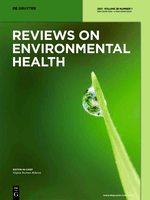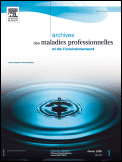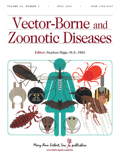
Revista de Salud Ambiental
Scope & Guideline
Transforming Environmental Challenges into Health Solutions
Introduction
Aims and Scopes
- Environmental Health Assessment:
The journal emphasizes methodologies for assessing environmental health risks, including air and water quality evaluations, biocidal risk assessments, and the monitoring of vector-borne diseases. - Interdisciplinary Research:
It promotes interdisciplinary research integrating fields such as public health, ecology, urban planning, and social sciences to address complex environmental health issues. - Innovative Technologies and Approaches:
The journal showcases innovative technologies and approaches in environmental health, such as genomic sequencing, GIS applications, and new biocidal alternatives, aimed at improving public health outcomes. - One Health Perspective:
There is a consistent focus on the One Health approach, which recognizes the interconnectedness of human, animal, and environmental health, particularly in addressing zoonotic diseases and antimicrobial resistance. - Public Engagement and Policy Impact:
The journal aims to foster citizen participation and inform policy through research findings, highlighting the role of community engagement in environmental health initiatives.
Trending and Emerging
- Microplastics and Human Health:
There is a significant increase in research related to the impacts of microplastics on human health, reflecting growing global concern over plastic pollution and its environmental consequences. - Climate Change and Health:
Emerging studies on the intersection of climate change and public health highlight the urgency of adapting health systems to mitigate the effects of climate variability on human health. - One Health Approach to Disease Management:
The One Health framework is increasingly prevalent, emphasizing the need for interdisciplinary collaboration to tackle zoonotic diseases and promote health across human, animal, and environmental domains. - Technological Innovations in Environmental Health:
Research focusing on innovative technologies, such as genomic sequencing and digital health tools for monitoring environmental risks, has gained prominence, reflecting a trend towards data-driven public health strategies. - Social Determinants of Health:
There is a growing emphasis on understanding the socio-environmental factors influencing health disparities, particularly in vulnerable populations, which aligns with broader public health goals of equity and access.
Declining or Waning
- Traditional Vector Control Methods:
Research on conventional vector control strategies has decreased, possibly due to a shift towards innovative and integrated pest management approaches that consider ecological impacts and sustainability. - Indoor Air Quality Studies:
Although indoor air quality remains important, studies specific to traditional pollutants have waned in favor of broader investigations into climate change impacts and their implications for public health. - Agricultural Pesticide Impact Studies:
Research specifically focused on the health impacts of traditional agricultural pesticides has lessened, likely due to growing interest in biocontrol methods and the ecological consequences of pesticide use. - Legionella Research Focus:
Studies specifically targeting Legionella and its control measures have become less frequent, indicating a potential shift towards a more holistic approach to waterborne diseases and environmental monitoring.
Similar Journals

Environnement Risques & Sante
Innovating Solutions for Environmental Health ChallengesEnvironnement Risques & Sante is a prominent journal focused on the intersection of environmental issues, public health, and safety, offering a platform for scholarly discourse on the critical challenges posed by environmental risks to human health. Published by JOHN LIBBEY EUROTEXT LTD, this journal aims to disseminate impactful research that enhances our understanding of toxicology, mutagenesis, and their implications for public health policy and practices. Though it ceased coverage in Scopus in 2021, its historical contributions remain relevant, addressing urgent topics in environmental science and occupational health. Researchers and professionals engaged in these fields will find valuable insights and findings that inform practice and promote sustainable solutions. For interested readers, further exploration of the journal can provide essential knowledge in coping with contemporary environmental health challenges.

Environmental Science & Technology Letters
Driving excellence in environmental science and technology.Environmental Science & Technology Letters, published by the American Chemical Society, stands as a premier journal in the realm of environmental science and technology, focusing on pivotal studies that address pressing environmental challenges. With an impressive Q1 ranking in multiple categories including Ecology, Environmental Chemistry, and Pollution, this journal maintains a position of excellence within its field, achieving Scopus ranks that place it in the top percentile of Environmental Science disciplines. Although not open access, Environmental Science & Technology Letters offers vital insights and cutting-edge research that contribute significantly to the understanding and management of environmental issues. The journal’s objectives include disseminating ground-breaking findings and promoting discussions that lead to sustainable solutions. With convergence from 2013 to 2024, it continues to serve as an essential resource for researchers, professionals, and students committed to advancing knowledge and innovation in environmental science.

Revista Eletronica em Gestao Educacao e Tecnologia Ambiental
Fostering innovative solutions at the intersection of education and sustainability.Revista Eletronica em Gestao Educacao e Tecnologia Ambiental, published by the Universidade Federal de Santa Maria, serves as a pivotal platform in the interdisciplinary fields of education management and environmental technology. Dedicated to advancing knowledge and fostering best practices in these critical areas, the journal features peer-reviewed articles, case studies, and innovative research that reflect the latest trends and findings. With an open access model, it ensures that valuable information is readily available to researchers, professionals, and students alike, promoting knowledge sharing and collaboration across borders. Although specific metrics such as impact factor and H-index are currently unavailable, the journal’s commitment to quality and relevance resonates within the academic community, making it an essential resource for those looking to contribute to the discourse on effective educational strategies and sustainable technological applications in environmental contexts. Based in Santa Maria, Brazil, this journal is ideally positioned to highlight regional research while engaging a global audience interested in progressive approaches to education and technology.

One Health
Transforming Health Through Collaborative KnowledgeOne Health is a premier open-access journal published by Elsevier, dedicated to advancing the interconnected disciplines of Infectious Diseases and Public Health. Established in 2015, the journal aims to promote holistic approaches to health that consider the interactions between humans, animals, and the environment. With an impressive impact factor and recognition in the top quartiles of both Infectious Diseases and Public Health categories, One Health ranks highly within the Scopus database, showcasing its significant contribution to the field. Situated in the Netherlands, the journal encourages scholarly communication and collaboration, providing a vital platform for researchers, professionals, and students to disseminate their findings and strengthen global health initiatives. By utilizing the open access model, One Health ensures that critical research is freely available, fostering a broader understanding of health-related issues that span multiple sectors.

REVIEWS ON ENVIRONMENTAL HEALTH
Uniting disciplines to tackle environmental health challenges.REVIEWS ON ENVIRONMENTAL HEALTH, published by Walter de Gruyter GmbH, serves as a critical platform for interdisciplinary research in the field of environmental health. With a history dating back to 1974, this journal has established itself as a reputable source for scholarly articles that address pressing issues at the intersection of public health, pollution, and environmental sciences. The journal is ranked in the Q2 category across multiple domains, including Health (social science), Pollution, and Public Health, evidencing its impact within an increasingly vital discourse. Researchers and professionals will find REVIEWS ON ENVIRONMENTAL HEALTH particularly valuable as it contributes significant insights and fosters dialogue on environmental health challenges and solutions, all while enhancing its global accessibility. The journal maintains a robust presence on platforms like Scopus, ranking in the 90th percentile in social sciences and 86th in public health, further accentuating its importance in the academic community. With access to comprehensive reviews and original research articles, this journal not only enriches the current literature but also paves the way for innovative approaches to safeguarding environmental and public health.

Pollution
Championing the fight against pollution through knowledge.Pollution is a distinguished open-access journal published by UNIV TEHRAN, dedicated to advancing the understanding of environmental science and the multifaceted aspects of pollution research. Since its establishment in 2015, the journal has been committed to disseminating high-quality, peer-reviewed articles that address the pressing issues of environmental degradation globally. With an impact factor and a Scopus rank that places it within the top tier of Environmental Science (Rank #141/233), Pollution serves as an essential resource for researchers, professionals, and students alike. The journal encompasses a wide range of topics, including the sources, effects, and mitigation strategies related to various forms of pollution, thereby aiming to contribute significantly to the scientific community's efforts in promoting environmental sustainability. Its innovative and timely approach positions Pollution as a vital platform for sharing knowledge and fostering interdisciplinary collaboration in the environmental science domain.

Biosafety and Health
Exploring the intersection of biosafety and public health.Biosafety and Health is a leading peer-reviewed journal published by ELSEVIER, dedicated to advancing knowledge and practice in the fields of biotechnology, infectious diseases, microbiology, and public health. With an ISSN of 2096-6962 and an E-ISSN of 2590-0536, this Open Access journal has been accessible to the global research community since 2019, fostering collaboration and innovation from its base in the Netherlands. Ranked Q2 in multiple categories according to the latest metrics, including Biotechnology and Microbiology (medical), it stands as a testament to high-quality, impactful research that influences clinical and environmental practices. The journal has achieved substantial recognition in various medical fields, ranking in the 88th percentile for Public Health, Environmental and Occupational Health, and the 78th percentile for Infectious Diseases. Researchers and practitioners seeking to contribute to this evolving domain are encouraged to submit their findings, as the journal aims to promote interdisciplinary dialogue and address pressing global health challenges.

Current Pollution Reports
Connecting Scholars for a Greener TomorrowCurrent Pollution Reports, published by Springer Heidelberg, is an esteemed journal in the field of environmental science, focusing on the multifaceted aspects of pollution, waste management, and water science. With an impressive 2023 impact factor reflected in its status as a Q1 journal across multiple categories—including Management, Monitoring, Policy and Law, Pollution, Waste Management and Disposal, and Water Science and Technology—this journal stands at the forefront of environmental research and policy discourse. The journal, which has been in publication since 2015, aims to provide a platform for scholars and practitioners to share their findings, promoting the exchange of innovative ideas and effective solutions to pressing environmental challenges. With its rigorous peer-review process, Current Pollution Reports serves as an invaluable resource for researchers, professionals, and students committed to understanding and addressing pollution and its impacts on our planet.

Archives des Maladies Professionnelles et de l Environnement
Championing Research that Shapes Policy and PracticeArchives des Maladies Professionnelles et de l'Environnement is a vital scholarly journal published by Elsevier Science Inc, focusing on the critical intersections of public health, environmental issues, and occupational health. With an ISSN of 1775-8785 and an E-ISSN of 1778-4190, this French-based journal serves as a platform for researchers, professionals, and students to explore contemporary challenges and advancements in these essential fields. Although it holds a Q4 ranking in the 2023 Scopus quartiles, it provides a unique opportunity for new contributions that can drive future research directions. The journal accepts a variety of article types, with the aim of spreading knowledge that can influence policy and improve practices in occupational health and environmental safety. As we approach the convergence of its publication years from 2004 to 2024, the journal remains committed to fostering a comprehensive understanding of the impact of work and environmental exposure on health, making it an important resource for anyone invested in these disciplines.

VECTOR-BORNE AND ZOONOTIC DISEASES
Bridging gaps in our understanding of zoonotic disease dynamics.VECTOR-BORNE AND ZOONOTIC DISEASES is a prominent journal dedicated to advancing research in the fields of infectious diseases, microbiology, and virology, published by Mary Ann Liebert, Inc. With a rich history spanning from 2001 to 2024, this journal plays a critical role in disseminating cutting-edge research and insights regarding diseases transmitted by vectors and zoonotic pathogens. It has achieved notable rankings, including Q2 in the Infectious Diseases category and Q3 in both Microbiology and Virology as of 2023. The journal's emphasis on quality and relevance is further underscored by its established position—ranked 151st in Infectious Diseases and within the 43rd percentile in Virology according to Scopus. Although not an open-access journal, the publication ensures that its findings reach a broad audience of researchers, professionals, and students dedicated to tackling the challenges posed by these critical health issues. By providing a platform for innovative studies and discussions, VECTOR-BORNE AND ZOONOTIC DISEASES remains an essential resource for those at the forefront of disease research and public health strategies.